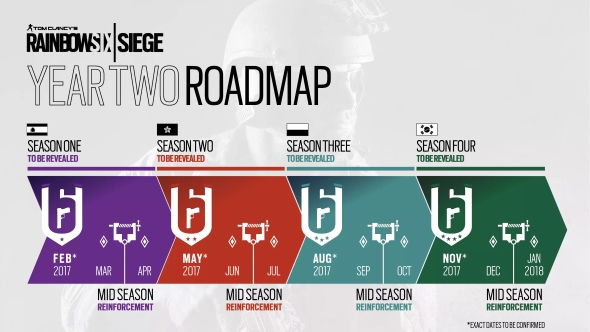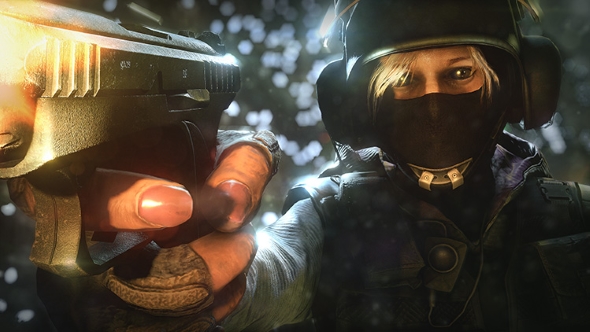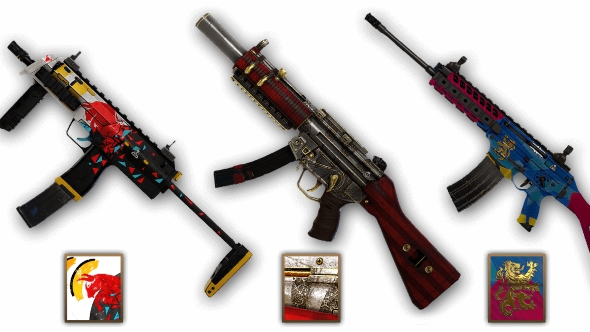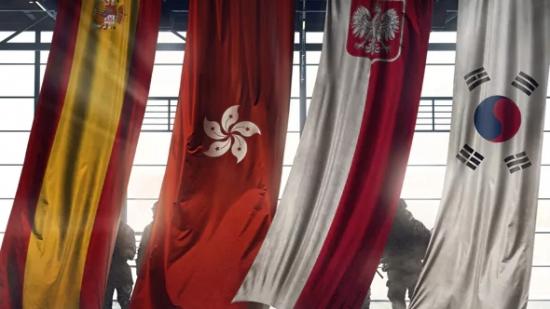Did you know that Rainbow Six Siege has 10 million players? For a game that often feels like it’s under the radar of many gamers, Siege has been quietly and consistently growing for a full year. And Ubisoft’s effort is paying off. Those 10 million players didn’t turn up for the heck of it; Siege is one of the best multiplayer games ever made, and it’s going to become even better in its second year.
Related: check out our rundown of the the best Rainbow Six Siege operators.
Over the next 12 months Siege will be expanded and improved with:
- Eight new operators hailing from Spain, Hong Kong, Poland, and South Korea
- Four new maps for each of the new operator nations
- Improvements to the game’s ‘health’, with better matchmaking and hit detection
- Loot packs awarding cosmetics
- A technical test server, akin to the PTR in The Division and Overwatch
- Further refinement of existing operators
That’s a huge amount of new things that we’ll see across year two of Siege. As with year one, these will be gradually delivered across four seasons, each headed up by a DLC expansion pack. The first is Velvet Shell, which we’ve already spent some extensive hands-on time with, and it deploys two exceptional operators in Jackal and Mira.
Siege is everything (that means no new game modes)

While there are plenty of exciting things to look forward to in year two of Siege, players should expect the overall experience to stay roughly the same. Ubisoft are not interested in adding new game modes to Rainbow Six, despite its competitors having numerous varied match types.
Talking during a presentation at Ubisoft Montreal’s headquarters, creative director Xavier Marquis explained: “The map can be different, the operators can be different, but we need something static to maintain the relationship between all the players and that is siege mode. Siege is the center of everything.”
Staying with the same attack and defend gameplay doesn’t mean Siege will go stale, though. Indeed, Ubisoft feel that this second year will be the period when Rainbow hits the big time. “We strongly believe that year two is going to be the Rainbow Six year,” explains brand director Alexandre Remy. “All these mini signals are coming together and I believe there’s going to be a snowball effect.”
Dedicated servers for everything
Remy feels that Siege can reach a critical mass of players by focusing on the health of the game. At current the game uses peer-to-peer systems to serve secondary systems such as voice chat, and this year we’ll see those switched over to the core peer-to-server technology. This will lead to increased stability and far more reliable connections for every player.
While Ubisoft have little to say about exactly how they’re planning to fix it, hit registration will be a big focus in 2017. Despite spending time working on it during 2016, the studio clearly feels like it’s not met audience expectations yet. Should they succeed though, players will experience less lag between shooting and hitting targets; the problems that lead to enemies killing you before you spot them.
New operators that redefine the meta
Health changes are all well and good, but they’re not the things that get players excited. Thankfully Siege will have plenty of that to go around, with new maps for each of the new nations – Spain, Hong Kong, Poland, and South Korea – and two new operators in each of the four expansions.
“We knew when we launched the game that we had a canvas of operators that was clearly not filled,” says Remy. “And the more we add operators, the more that canvas begins to fill as a whole.”
He notes that new puzzle pieces will solve existing issues, such as when Hibana was introduced to stop Thermite being the only reinforced breaching character. “Overall, by increasing the number of operators we increase the number of choices,” he explains. “Some of them are going to be designed to offer those choices like Thermite and Hibana, some are to offer a better counter to the operators that are an automatic pick. Building the meta is a whole game.”
Mira’s crazy Black Mirror gadget feels far outside the field of skills we’ve come to expect from Rainbow Six, and it appears we’ll be seeing more inventive abilities as the year goes on. “[Creative director] Xavier Marquis likes to push things outside of expectations,” laughs Remy. “I know he already has crazy ideas for new operators that are outside of what you would expect. There’s tons of super cool ones we have prototyped.”
One such operator we’ll unfortunately never see really shatters the rules. “There was an operator that was usable in attack and defence,” reveals Remy. “It would transverse between the two. But it was creating confusion in the pick phase. So if he was picked by one side did he become unavailable to the other? There were a lot of headaches and questions.
“But the board of ideas for operators is so huge, and we’re far from being at the end of it,” continues Remy. “These are the kind of boundaries the design team are trying to push.”
Old favourites buffed, nerfed, and reborn

If your favourite operator lies within the original launch pool, there’s still reason to be excited. Ubisoft plan to revisit existing characters and refine them. “There’s going to be some big improvements to the models, to change the gadgets, or to change a deep aspect of the design, depending on the operator,” Remy says. On a case-by-case basis, we could see anything from a simple visual remodel to a complete overhaul of the operator and their skill.
Remy points at Siege’s LMG defender as an example as to what we could see in year two. “Some operators are going to need a much bigger nerf or buff. Tachanka I think is a good example. His 3D gadget model has been reworked, it takes much [more] time and thought to set up. I think he’s in a much better place, even though he’s still not in the best place.” It almost seems guaranteed that Ubi will be looking to make Tachanka a far more viable pick by the end of the year.
Even if your favourite operator is in a great place mechanically, you’ll still be able to do even more customisation with them thanks to the new loot packs. Due to be introduced around 2017’s second season, they’re clearly influenced by Overwatch’s loot box system. While details are not concrete, they’ll be unlocked after playing for a certain amount of time and contain random cosmetic items from the microtransaction store. For anyone who doesn’t want to spend real money or in-game renown on cosmetics, these loot packs are going to help build up a skins collection.

It’s unusual to see a Ubisoft game roll into its second year of updates. Coming from publishers seemingly dedicated to annualised sandbox games, you’d be forgiven for thinking that Rainbow Six would have a few months of DLC before being abandoned to the wilderness. Thankfully that’s certainly not the case; Siege is looking to have an even stronger feature set by the end of year two, and the Montreal studio intends for its life to continue long after then.
“I think [when we pitched Siege] we were at a good time when Ubisoft were much more inclined to thinking about and discussing games as a service,” recalls Remy. “In the first and second season there was the moment where we realised that it works, and it allowed us to put together a roadmap that was much, much longer than we would do otherwise.”
With a player count that’s 10 million strong and with no signs of shrinking, it would appear that Rainbow Six is here to stay. Not only that, but if For Honor’s multiplayer is anything to judge by, it looks like Siege has been the influence for a whole new chapter in Ubisoft’s history.
